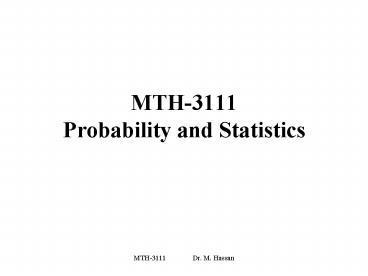MTH3111 Probability and Statistics PowerPoint PPT Presentation
1 / 19
Title: MTH3111 Probability and Statistics
1
MTH-3111Probability and Statistics
- ??? ???? ?????? ??????
2
Course details
- Instructor Dr. Mohamed H. Hassan
- Office Deputy Dean (Academic Affairs).
- Phone 4411
- mhhassan_at_iiu.edu.my
- Course 3 credits, 3 Lecture hours, 1 hours
tutoring (Sign up sheet for tutorials). - Text Applied Statistics and Probability for
Engineers, D. C. Montgomery and G. C. Runger, 3rd
edition, John Wiley Sons, Inc.
3
Course details
- Quiz during tutorial from assignment problems
- Changing of Quiz grades can only be done during
the first week after getting the grades. - Course outline lecture notes are posted on
- http//eng.iiu.edu.my/mhassan/MTH-3111
4
Dress code in attending classes
- Matric card must always be displayed.
- No round neck shirt.
- No slippers.
- No tight pants or shirt.
- No long hair for brothers (cap should be removed
while in the classroom)
5
(No Transcript)
6
Learning outcomes
- After completing this course, the student should
be able to - Define sample space and event and calculate
probability calculation of an event, conditional
probability and total probability. - Define probability mass function and cumulative
distribution function. - Apply Binomial, Poisson, exponential and normal
distribution for modelling empirical phenomenon. - Understand and use Central Limit Theorem to find
sampling distribution of mean and use it to find
interval estimation. - Define hypothesis testing and to calculate the
test statistic for mean of a normal distribution,
p-value, type I error, type II error, and power
of a test statistic. - Find linear regression estimator by using least
squares method and make and analyse a simple
design of experiment.
7
Introduction
The Engineering method for problem solving
8
Introduction (Cont.)
- Engineers must know how to efficiently plan
experiments, collect data, analyze and interpret
the data, and understand how the observed data
are related to the model they have proposed for
the problem under study. - Statistics Deals with the collection,
presentation, analysis, and use of data to make
decisions, solve problems, and design products
and processes.
9
(No Transcript)
10
Variability
- Variability Successive observations of a system
or phenomena do not produce exactly the same
result. - Statistical methods are used to help us describe
and understand variability. It also can give us
a useful way to incorporate this variability into
our decision-making processes.
11
Variability (examples)
- Car gasoline mileage performance
- Observed variability in gasoline mileage depends
on many factors (sources of variability), such as
the type of driving, vehicle condition, the
brand and/or octane number of the gasoline used,
weather conditions. - Statistics gives us a framework for describing
this variability and for learning about which
potential sources of variability are the most
important or which have the greatest impact on
the gasoline mileage performance.
12
Variability (examples)
- Designing a nylon connector to be used in an
automotive engine application. - We specify design specification on wall
thickness, and determine effect on the connector
pull-off force. - Eight prototype units are produced and their
pull-off forces measured. Not all of the
prototypes have the same pull-off force. - We say that there is variability in the pull-off
force measurements. THUS, we consider the
pull-off force to be a random variable. - We often need to describe, quantify and
ultimately reduce variability.
13
(No Transcript)
14
Data collecting methods
- Basic methods of collecting data
- A retrospective study using historical data
- An observational study
- A designed experiment
- An effective data collection procedure can
greatly simplify the analysis and lead to
improved understanding of the population or
process that is being studied.
15
Retrospective study
- A retrospective study would use either all or a
sample of the historical process data archived
over some period of time. - It presents some problems Data didnt change
much over the historical period. Effects of
process variables may be difficult to separate.
16
Observational Study
- The engineer observes the process or population,
disturbing it as little as possible, and records
the quantities of interest. - Because these studies are usually conducted for a
relatively short time period, sometimes variables
that are not routinely measured can be included.
It goes a long way toward obtaining accurate and
reliable data. - STILL, Effects of process variables may be
difficult to separate.
17
Designed Experiments
- The engineer makes deliberate or purposeful
changes in the controllable variables of the
system or process, observes the resulting system
output data, and then makes an inference or
decision about which variables are responsible
for the observed changes in output performance. - With designed experiments
- Products and processes enjoy better performance,
higher reliability, and lower overall costs. - They play a crucial role in reducing the lead
time for engineering design and development
activities.
18
(No Transcript)
19
Statistical inference

